engine Citroen C5 2008 (RD/TD) / 2.G Owner's Manual
[x] Cancel search | Manufacturer: CITROEN, Model Year: 2008, Model line: C5, Model: Citroen C5 2008 (RD/TD) / 2.GPages: 240, PDF Size: 5.78 MB
Page 4 of 240
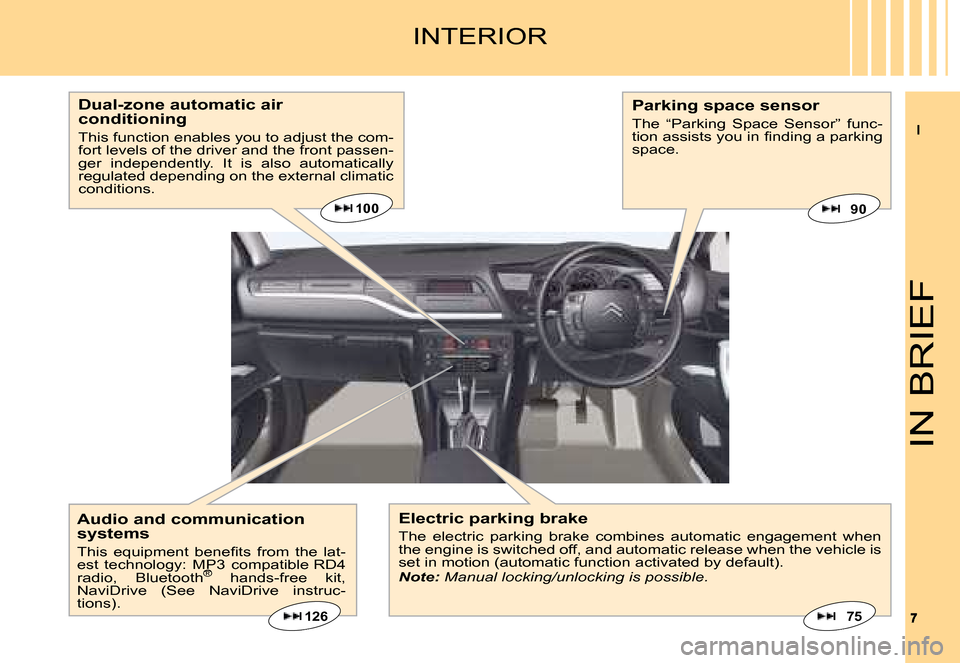
II
77
IN BRIEF
INTERIOR
Electric parking brake
The electric parking brake combines automatic engagement when the engine is switched off, and automatic release when the vehicle is set in motion (automatic function activated by default).Note: Manual locking/unlocking is possible.
Parking space sensor
The “Parking Space Sensor” func-�t�i�o�n� �a�s�s�i�s�t�s� �y�o�u� �i�n� �fi� �n�d�i�n�g� �a� �p�a�r�k�i�n�g� space.
12675
Dual-zone automatic air conditioning
This function enables you to adjust the com-fort levels of the driver and the front passen-ger independently. It is also automatically regulated depending on the external climatic conditions.
100
Audio and communication systems
�T�h�i�s� �e�q�u�i�p�m�e�n�t� �b�e�n�e�fi� �t�s� �f�r�o�m� �t�h�e� �l�a�t�-est technology: MP3 compatible RD4 radio, Bluetooth®technology: MP3 technology: MP3 hands-free kit, ®
NaviDrive (See NaviDrive instruc-tions).
90
Page 12 of 240
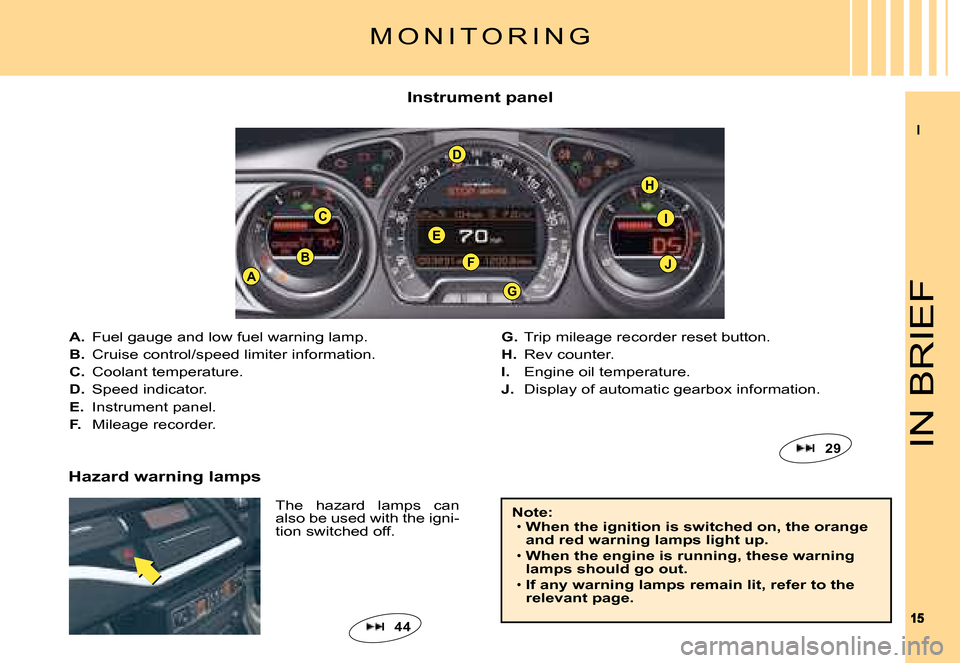
II
1515
E
D
FAJ
CI
B
H
G
IN BRIEF
Instrument panel
The hazard lamps can also be used with the igni-tion switched off.
M O N I T O R I N G
A. Fuel gauge and low fuel warning lamp.
B. Cruise control/speed limiter information.
C. Coolant temperature.
D. Speed indicator.
E. Instrument panel.
F. Mileage recorder.
G. Trip mileage recorder reset button.
H. Rev counter.
I. Engine oil temperature.
J. Display of automatic gearbox information.
Note:When the ignition is switched on, the orange and red warning lamps light up.
When the engine is running, these warning lamps should go out.
If any warning lamps remain lit, refer to the relevant page.
Page 15 of 240
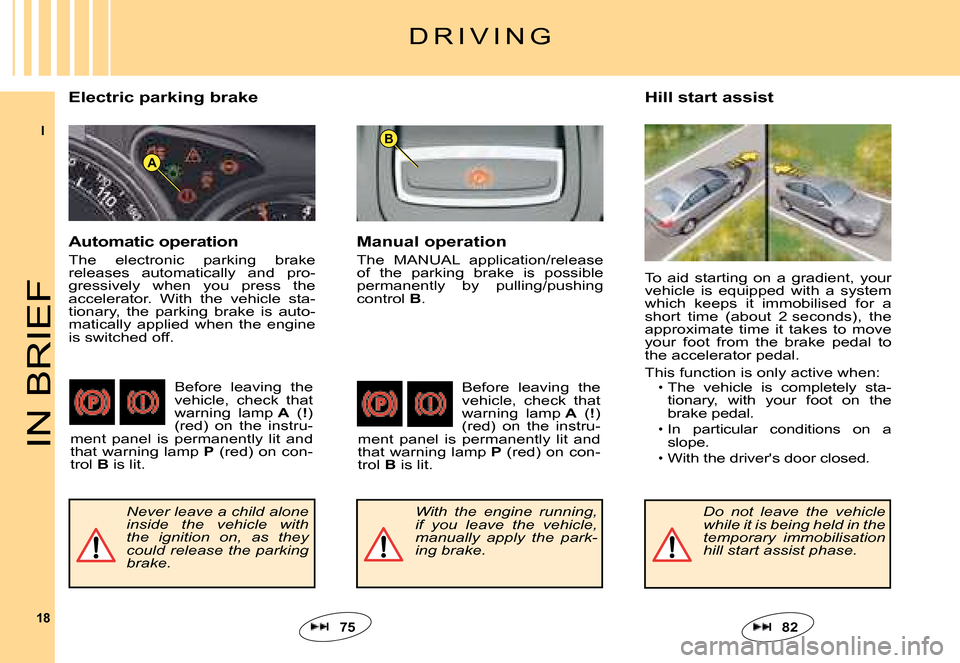
I
18
B
A
IN BRIEF
D R I V I N G
Electric parking brake
75
Never leave a child alone inside the vehicle with the ignition on, as they could release the parking brake.
Hill start assist
Manual operation
The MANUAL application/release of the parking brake is possible permanently by pulling/pushing control B.
Before leaving the vehicle, check that warning lamp A (!) (red) on the instru-ment panel is permanently lit and that warning lamp P (red) on con-trol B is lit.
With the engine running, if you leave the vehicle, manually apply the park-ing brake.
Do not leave the vehicle while it is being held in the temporary immobilisation hill start assist phase.
To aid starting on a gradient, your vehicle is equipped with a system which keeps it immobilised for a short time (about 2 seconds), the approximate time it takes to move your foot from the brake pedal to the accelerator pedal.
This function is only active when:The vehicle is completely sta-tionary, with your foot on the brake pedal.
In particular conditions on a slope.With the driver's door closed.
Page 21 of 240
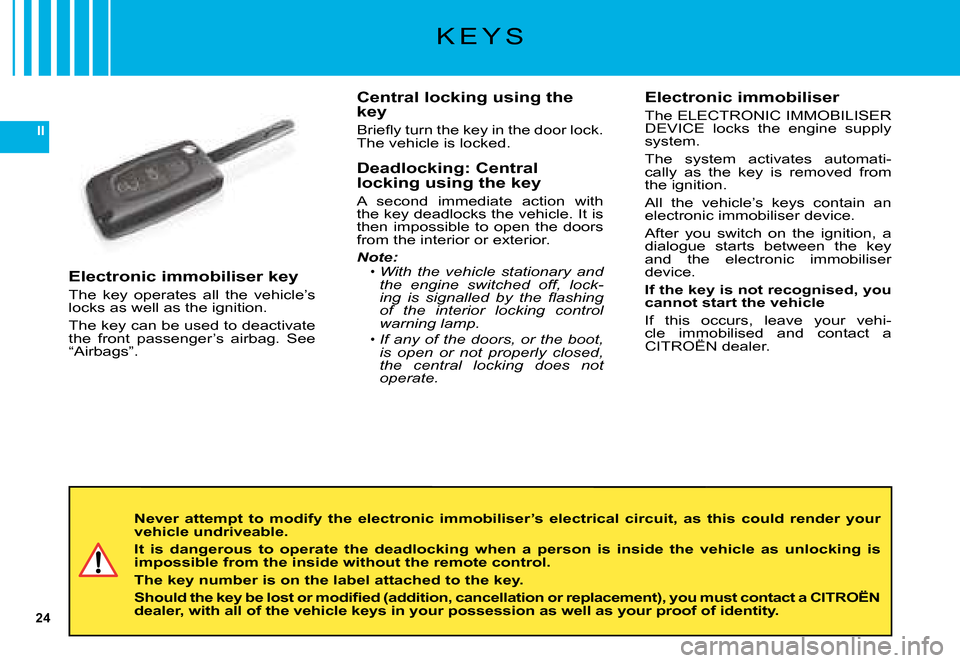
24
II
K E Y S
Never attempt to modify the electronic immobiliser’s electrical circuit, as this could render your vehicle undriveable.
It is dangerous to operate the deadlocking when a person is inside the vehicle as unlocking is impossible from the inside without the remote control.
The key number is on the label attached to the key.
�S�h�o�u�l�d� �t�h�e� �k�e�y� �b�e� �l�o�s�t� �o�r� �m�o�d�i�fi� �e�d� �(�a�d�d�i�t�i�o�n�,� �c�a�n�c�e�l�l�a�t�i�o�n� �o�r� �r�e�p�l�a�c�e�m�e�n�t�)�,� �y�o�u� �m�u�s�t� �c�o�n�t�a�c�t� �a� �C�I�T�R�O��N � dealer, with all of the vehicle keys in your possession as well as your proof of identity.
Central locking using the key
�B�r�i�e�fl� �y� �t�u�r�n� �t�h�e� �k�e�y� �i�n� �t�h�e� �d�o�o�r� �l�o�c�k�.� �T�h�e� �v�e�h�i�c�l�e� �i�s� �l�o�c�k�e�d�.
Deadlocking: Central locking using the key
�A� �s�e�c�o�n�d� �i�m�m�e�d�i�a�t�e� �a�c�t�i�o�n� �w�i�t�h� �t�h�e� �k�e�y� �d�e�a�d�l�o�c�k�s� �t�h�e� �v�e�h�i�c�l�e�.� �I�t� �i�s� �t�h�e�n� �i�m�p�o�s�s�i�b�l�e� �t�o� �o�p�e�n� �t�h�e� �d�o�o�r�s� �f�r�o�m� �t�h�e� �i�n�t�e�r�i�o�r� �o�r� �e�x�t�e�r�i�o�r�.
Note:With the vehicle stationary and the engine switched off, lock-�i�n�g� �i�s� �s�i�g�n�a�l�l�e�d� �b�y� �t�h�e� �fl� �a�s�h�i�n�g� of the interior locking control warning lamp.
If any of the doors, or the boot, is open or not properly closed, the central locking does not operate.
Page 24 of 240
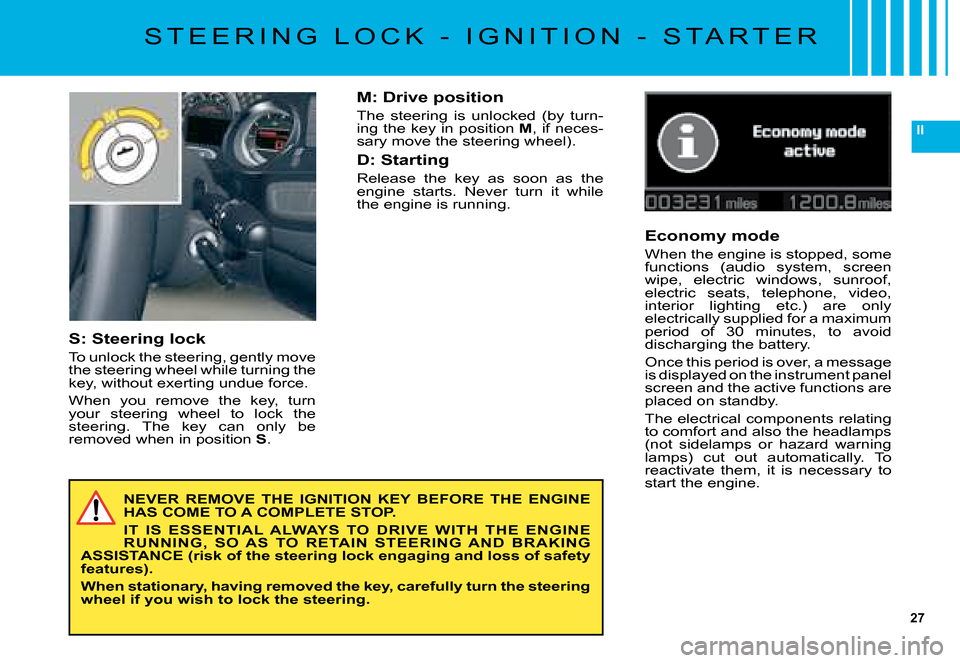
27
II
�S �T �E �E �R �I �N �G � �L �O �C �K � �- � �I �G �N �I �T �I �O �N � �- � �S �T �A �R �T �E �R
NEVER REMOVE THE IGNITION KEY BEFORE THE ENGINE HAS COME TO A COMPLETE STOP.
IT IS ESSENTIAL ALWAYS TO DRIVE WITH THE ENGINE RUNNING, SO AS TO RETAIN STEERING AND BRAKING �A�S�S�I�S�T�A�N�C�E� �(�r�i�s�k� �o�f� �t�h�e� �s�t�e�e�r�i�n�g� �l�o�c�k� �e�n�g�a�g�i�n�g� �a�n�d� �l�o�s�s� �o�f� �s�a�f�e�t�y� �f�e�a�t�u�r�e�s�)�.
When stationary, having removed the key, carefully turn the steering wheel if you wish to lock the steering.
S: Steering lock
�T�o� �u�n�l�o�c�k� �t�h�e� �s�t�e�e�r�i�n�g�,� �g�e�n�t�l�y� �m�o�v�e� �t�h�e� �s�t�e�e�r�i�n�g� �w�h�e�e�l� �w�h�i�l�e� �t�u�r�n�i�n�g� �t�h�e� �k�e�y�,� �w�i�t�h�o�u�t� �e�x�e�r�t�i�n�g� �u�n�d�u�e� �f�o�r�c�e�.
�W�h�e�n� �y�o�u� �r�e�m�o�v�e� �t�h�e� �k�e�y�,� �t�u�r�n� �y�o�u�r� �s�t�e�e�r�i�n�g� �w�h�e�e�l� �t�o� �l�o�c�k� �t�h�e� �s�t�e�e�r�i�n�g�.� �T�h�e� �k�e�y� �c�a�n� �o�n�l�y� �b�e� �r�e�m�o�v�e�d� �w�h�e�n� �i�n� �p�o�s�i�t�i�o�n� S.
Economy mode
�W�h�e�n� �t�h�e� �e�n�g�i�n�e� �i�s� �s�t�o�p�p�e�d�,� �s�o�m�e� �f�u�n�c�t�i�o�n�s� �(�a�u�d�i�o� �s�y�s�t�e�m�,� �s�c�r�e�e�n� �w�i�p�e�,� �e�l�e�c�t�r�i�c� �w�i�n�d�o�w�s�,� �s�u�n�r�o�o�f�,� �e�l�e�c�t�r�i�c� �s�e�a�t�s�,� �t�e�l�e�p�h�o�n�e�,� �v�i�d�e�o�,� �i�n�t�e�r�i�o�r� �l�i�g�h�t�i�n�g� �e�t�c�.�)� �a�r�e� �o�n�l�y� �e�l�e�c�t�r�i�c�a�l�l�y� �s�u�p�p�l�i�e�d� �f�o�r� �a� �m�a�x�i�m�u�m� �p�e�r�i�o�d� �o�f� �3�0� �m�i�n�u�t�e�s�,� �t�o� �a�v�o�i�d� �d�i�s�c�h�a�r�g�i�n�g� �t�h�e� �b�a�t�t�e�r�y�.
�O�n�c�e� �t�h�i�s� �p�e�r�i�o�d� �i�s� �o�v�e�r�,� �a� �m�e�s�s�a�g�e� �i�s� �d�i�s�p�l�a�y�e�d� �o�n� �t�h�e� �i�n�s�t�r�u�m�e�n�t� �p�a�n�e�l� �s�c�r�e�e�n� �a�n�d� �t�h�e� �a�c�t�i�v�e� �f�u�n�c�t�i�o�n�s� �a�r�e� �p�l�a�c�e�d� �o�n� �s�t�a�n�d�b�y�.
�T�h�e� �e�l�e�c�t�r�i�c�a�l� �c�o�m�p�o�n�e�n�t�s� �r�e�l�a�t�i�n�g� �t�o� �c�o�m�f�o�r�t� �a�n�d� �a�l�s�o� �t�h�e� �h�e�a�d�l�a�m�p�s� �(�n�o�t� �s�i�d�e�l�a�m�p�s� �o�r� �h�a�z�a�r�d� �w�a�r�n�i�n�g� �l�a�m�p�s�)� �c�u�t� �o�u�t� �a�u�t�o�m�a�t�i�c�a�l�l�y�.� �T�o� �r�e�a�c�t�i�v�a�t�e� �t�h�e�m�,� �i�t� �i�s� �n�e�c�e�s�s�a�r�y� �t�o� �s�t�a�r�t� �t�h�e� �e�n�g�i�n�e�.
M: Drive position
�T�h�e� �s�t�e�e�r�i�n�g� �i�s� �u�n�l�o�c�k�e�d� �(�b�y� �t�u�r�n�-�i�n�g� �t�h�e� �k�e�y� �i�n� �p�o�s�i�t�i�o�n� M�,� �i�f� �n�e�c�e�s�-�s�a�r�y� �m�o�v�e� �t�h�e� �s�t�e�e�r�i�n�g� �w�h�e�e�l�)�.
D: Starting
�R�e�l�e�a�s�e� �t�h�e� �k�e�y� �a�s� �s�o�o�n� �a�s� �t�h�e� �e�n�g�i�n�e� �s�t�a�r�t�s�.� �N�e�v�e�r� �t�u�r�n� �i�t� �w�h�i�l�e� �t�h�e� �e�n�g�i�n�e� �i�s� �r�u�n�n�i�n�g�.
Page 25 of 240
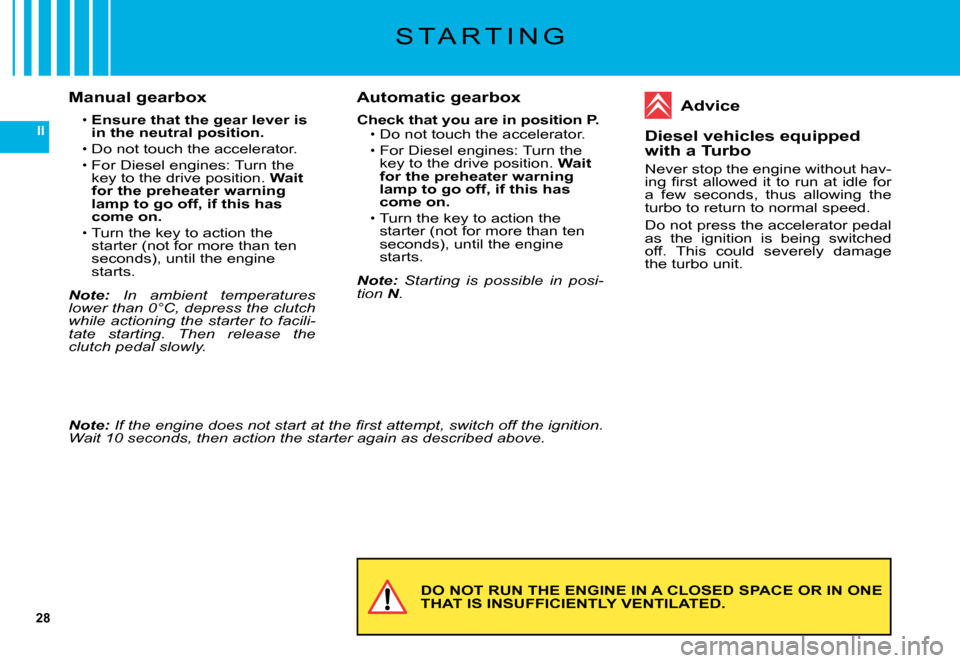
28
II
DO NOT RUN THE ENGINE IN A CLOSED SPACE OR IN ONE THAT IS INSUFFICIENTLY VENTILATED.
Manual gearbox
Ensure that the gear lever is in the neutral position.�D�o� �n�o�t� �t�o�u�c�h� �t�h�e� �a�c�c�e�l�e�r�a�t�o�r�.
�F�o�r� �D�i�e�s�e�l� �e�n�g�i�n�e�s�:� �T�u�r�n� �t�h�e� �k�e�y� �t�o� �t�h�e� �d�r�i�v�e� �p�o�s�i�t�i�o�n�.� Wait for the preheater warning lamp to go off, if this has come on.
�T�u�r�n� �t�h�e� �k�e�y� �t�o� �a�c�t�i�o�n� �t�h�e� �s�t�a�r�t�e�r� �(�n�o�t� �f�o�r� �m�o�r�e� �t�h�a�n� �t�e�n� �s�e�c�o�n�d�s�)�,� �u�n�t�i�l� �t�h�e� �e�n�g�i�n�e� �s�t�a�r�t�s�.
Note: In ambient temperatures lower than 0°C, depress the clutch while actioning the starter to facili-tate starting. Then release the clutch pedal slowly.
Page 27 of 240
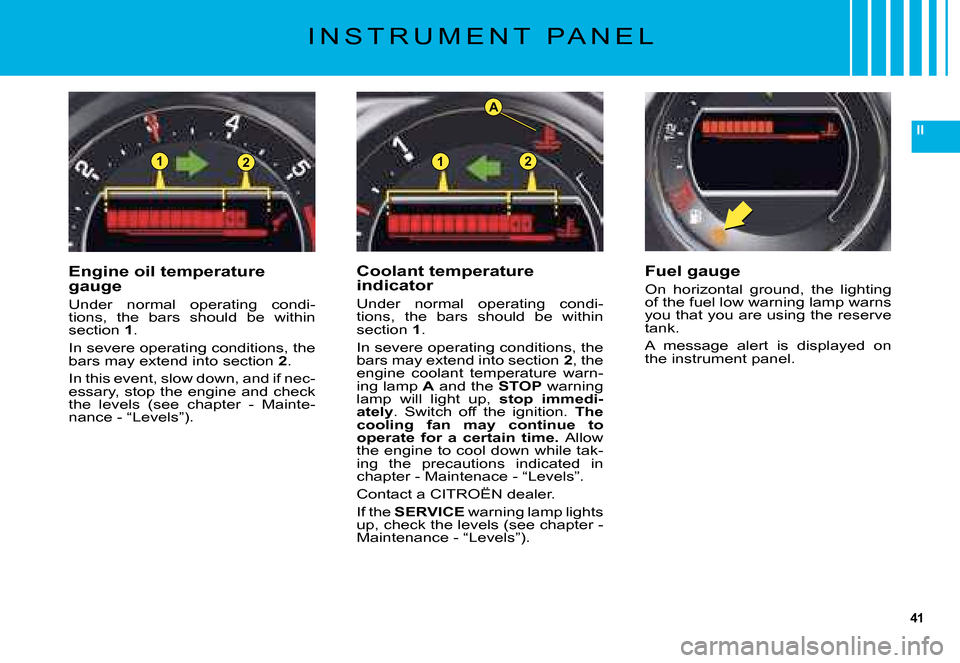
41
II
A
2121
I N S T R U M E N T P A N E L
Engine oil temperature gauge
�U�n�d�e�r� �n�o�r�m�a�l� �o�p�e�r�a�t�i�n�g� �c�o�n�d�i�-�t�i�o�n�s�,� �t�h�e� �b�a�r�s� �s�h�o�u�l�d� �b�e� �w�i�t�h�i�n� section 1.
�I�n� �s�e�v�e�r�e� �o�p�e�r�a�t�i�n�g� �c�o�n�d�i�t�i�o�n�s�,� �t�h�e� �b�a�r�s� �m�a�y� �e�x�t�e�n�d� �i�n�t�o� �s�e�c�t�i�o�n� 2.
�I�n� �t�h�i�s� �e�v�e�n�t�,� �s�l�o�w� �d�o�w�n�,� �a�n�d� �i�f� �n�e�c�-�e�s�s�a�r�y�,� �s�t�o�p� �t�h�e� �e�n�g�i�n�e� �a�n�d� �c�h�e�c�k� �t�h�e� �l�e�v�e�l�s� �(�s�e�e� �c�h�a�p�t�e�r� �-� �M�a�i�n�t�e�-�n�a�n�c�e� �-� �“�L�e�v�e�l�s�”�)�.
Fuel gauge
�O�n� �h�o�r�i�z�o�n�t�a�l� �g�r�o�u�n�d�,� �t�h�e� �l�i�g�h�t�i�n�g� �o�f� �t�h�e� �f�u�e�l� �l�o�w� �w�a�r�n�i�n�g� �l�a�m�p� �w�a�r�n�s� �y�o�u� �t�h�a�t� �y�o�u� �a�r�e� �u�s�i�n�g� �t�h�e� �r�e�s�e�r�v�e� �t�a�n�k�.
�A� �m�e�s�s�a�g�e� �a�l�e�r�t� �i�s� �d�i�s�p�l�a�y�e�d� �o�n� �t�h�e� �i�n�s�t�r�u�m�e�n�t� �p�a�n�e�l�.
Coolant temperature indicator
�U�n�d�e�r� �n�o�r�m�a�l� �o�p�e�r�a�t�i�n�g� �c�o�n�d�i�-�t�i�o�n�s�,� �t�h�e� �b�a�r�s� �s�h�o�u�l�d� �b�e� �w�i�t�h�i�n� section 1.
�I�n� �s�e�v�e�r�e� �o�p�e�r�a�t�i�n�g� �c�o�n�d�i�t�i�o�n�s�,� �t�h�e� �b�a�r�s� �m�a�y� �e�x�t�e�n�d� �i�n�t�o� �s�e�c�t�i�o�n� 2�,� �t�h�e� �e�n�g�i�n�e� �c�o�o�l�a�n�t� �t�e�m�p�e�r�a�t�u�r�e� �w�a�r�n�-�i�n�g� �l�a�m�p� A� �a�n�d� �t�h�e� STOP� �w�a�r�n�i�n�g� �l�a�m�p� �w�i�l�l� �l�i�g�h�t� �u�p�,� stop immedi-ately.�S�w�i�t�c�h� �o�f�f� �t�h�e� �i�g�n�i�t�i�o�n�.� The cooling fan may continue to operate for a certain time. �A�l�l�o�w� �t�h�e� �e�n�g�i�n�e� �t�o� �c�o�o�l� �d�o�w�n� �w�h�i�l�e� �t�a�k�-�i�n�g� �t�h�e� �p�r�e�c�a�u�t�i�o�n�s� �i�n�d�i�c�a�t�e�d� �i�n� �c�h�a�p�t�e�r� �-� �M�a�i�n�t�e�n�a�c�e� �-� �“�L�e�v�e�l�s�”�.
�C�o�n�t�a�c�t� �a� �C�I�T�R�O��N� �d�e�a�l�e�r�.
If the SERVICE� �w�a�r�n�i�n�g� �l�a�m�p� �l�i�g�h�t�s� �u�p�,� �c�h�e�c�k� �t�h�e� �l�e�v�e�l�s� �(�s�e�e� �c�h�a�p�t�e�r� �-� �M�a�i�n�t�e�n�a�n�c�e� �-� �“�L�e�v�e�l�s�”�)�.
Page 28 of 240
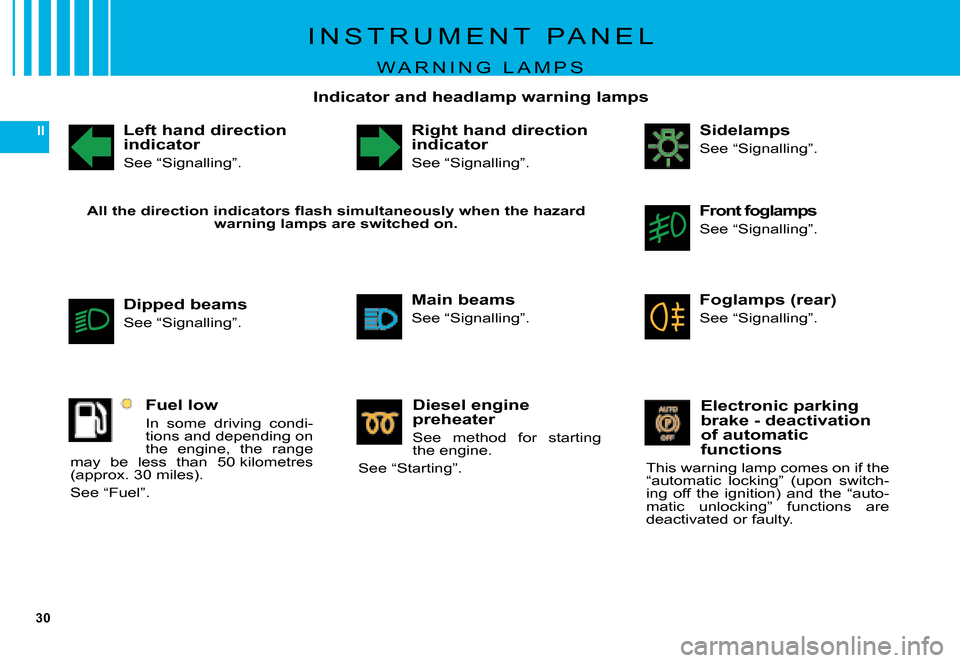
30
II
I N S T R U M E N T P A N E L
W A R N I N G L A M P S
Left hand direction indicator
�S�e�e� �“�S�i�g�n�a�l�l�i�n�g�”�.
Right hand direction indicator
�S�e�e� �“�S�i�g�n�a�l�l�i�n�g�”�.
Sidelamps
�S�e�e� �“�S�i�g�n�a�l�l�i�n�g�”�.
Front foglamps
�S�e�e� �“�S�i�g�n�a�l�l�i�n�g�”�.
Dipped beams
�S�e�e� �“�S�i�g�n�a�l�l�i�n�g�”�.
�F�o�g�l�a�m�p�s� �(�r�e�a�r�)
�S�e�e� �“�S�i�g�n�a�l�l�i�n�g�”�.
Main beams
�S�e�e� �“�S�i�g�n�a�l�l�i�n�g�”�.
�A�l�l� �t�h�e� �d�i�r�e�c�t�i�o�n� �i�n�d�i�c�a�t�o�r�s� �fl� �a�s�h� �s�i�m�u�l�t�a�n�e�o�u�s�l�y� �w�h�e�n� �t�h�e� �h�a�z�a�r�d� warning lamps are switched on.
Indicator and headlamp warning lamps
Fuel low
�I�n� �s�o�m�e� �d�r�i�v�i�n�g� �c�o�n�d�i�-�t�i�o�n�s� �a�n�d� �d�e�p�e�n�d�i�n�g� �o�n� �t�h�e� �e�n�g�i�n�e�,� �t�h�e� �r�a�n�g�e� �m�a�y� �b�e� �l�e�s�s� �t�h�a�n� �5�0� �k�i�l�o�m�e�t�r�e�s� �(�a�p�p�r�o�x�.� �3�0� �m�i�l�e�s�)�.
�S�e�e� �“�F�u�e�l�”�.
Diesel engine preheater
�S�e�e� �m�e�t�h�o�d� �f�o�r� �s�t�a�r�t�i�n�g� �t�h�e� �e�n�g�i�n�e�.
�S�e�e� �“�S�t�a�r�t�i�n�g�”�.
Electronic parking brake - deactivation of automatic functions
�T�h�i�s� �w�a�r�n�i�n�g� �l�a�m�p� �c�o�m�e�s� �o�n� �i�f� �t�h�e� �“�a�u�t�o�m�a�t�i�c� �l�o�c�k�i�n�g�”� �(�u�p�o�n� �s�w�i�t�c�h�-�i�n�g� �o�f�f� �t�h�e� �i�g�n�i�t�i�o�n�)� �a�n�d� �t�h�e� �“�a�u�t�o�-�m�a�t�i�c� �u�n�l�o�c�k�i�n�g�”� �f�u�n�c�t�i�o�n�s� �a�r�e� �d�e�a�c�t�i�v�a�t�e�d� �o�r� �f�a�u�l�t�y�.
Page 29 of 240
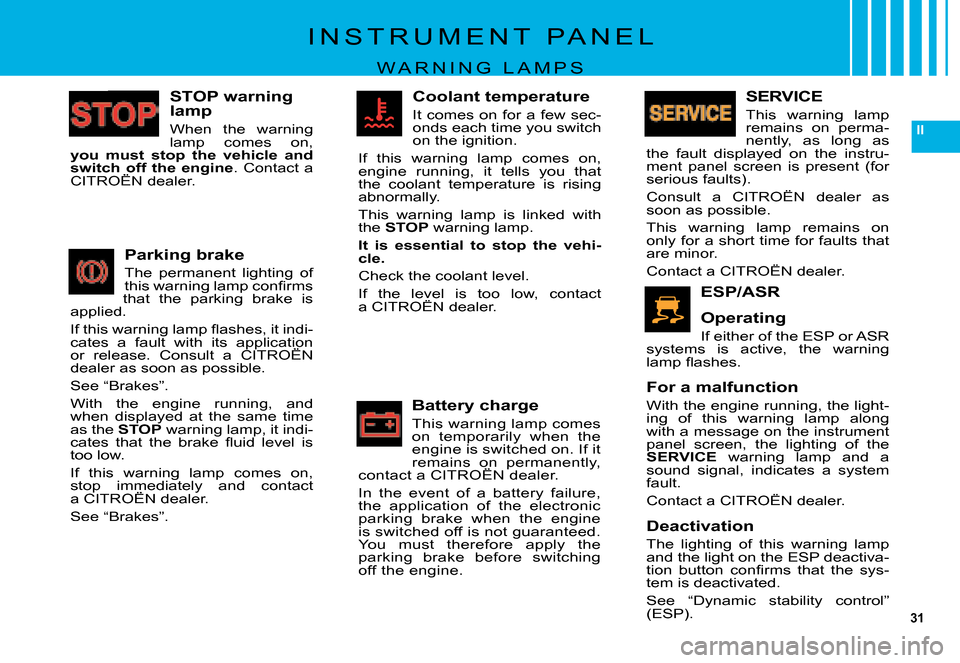
31
II
STOP warning lamp
�W�h�e�n� �t�h�e� �w�a�r�n�i�n�g� �l�a�m�p� �c�o�m�e�s� �o�n�,� you must stop the vehicle and switch off the engine�.� �C�o�n�t�a�c�t� �a� �C�I�T�R�O��N� �d�e�a�l�e�r�.switch off the engineswitch off
Parking brake
�T�h�e� �p�e�r�m�a�n�e�n�t� �l�i�g�h�t�i�n�g� �o�f� �t�h�i�s� �w�a�r�n�i�n�g� �l�a�m�p� �c�o�n�fi� �r�m�s� �t�h�a�t� �t�h�e� �p�a�r�k�i�n�g� �b�r�a�k�e� �i�s� �a�p�p�l�i�e�d�.
�I�f� �t�h�i�s� �w�a�r�n�i�n�g� �l�a�m�p� �fl� �a�s�h�e�s�,� �i�t� �i�n�d�i�-�c�a�t�e�s� �a� �f�a�u�l�t� �w�i�t�h� �i�t�s� �a�p�p�l�i�c�a�t�i�o�n� �o�r� �r�e�l�e�a�s�e�.� �C�o�n�s�u�l�t� �a� �C�I�T�R�O��N� �c�a�t�e�s� �a� �f�a�u�l�t� �w�i�t�h� �i�t�s� �a�p�p�l�i�c�a�t�i�o�n� �c�a�t�e�s� �a� �f�a�u�l�t� �w�i�t�h� �i�t�s� �a�p�p�l�i�c�a�t�i�o�n�
�d�e�a�l�e�r� �a�s� �s�o�o�n� �a�s� �p�o�s�s�i�b�l�e�.
�S�e�e� �“�B�r�a�k�e�s�”�.
�W�i�t�h� �t�h�e� �e�n�g�i�n�e� �r�u�n�n�i�n�g�,� �a�n�d� �w�h�e�n� �d�i�s�p�l�a�y�e�d� �a�t� �t�h�e� �s�a�m�e� �t�i�m�e� �a�s� �t�h�e� STOP� �w�a�r�n�i�n�g� �l�a�m�p�,� �i�t� �i�n�d�i�-�c�a�t�e�s� �t�h�a�t� �t�h�e� �b�r�a�k�e� �fl� �u�i�d� �l�e�v�e�l� �i�s� �t�o�o� �l�o�w�.
�I�f� �t�h�i�s� �w�a�r�n�i�n�g� �l�a�m�p� �c�o�m�e�s� �o�n�,� �s�t�o�p� �i�m�m�e�d�i�a�t�e�l�y� �a�n�d� �c�o�n�t�a�c�t� �a� �C�I�T�R�O��N� �d�e�a�l�e�r�.�s�t�o�p� �i�m�m�e�d�i�a�t�e�l�y� �a�n�d� �c�o�n�t�a�c�t� �s�t�o�p� �i�m�m�e�d�i�a�t�e�l�y� �a�n�d� �c�o�n�t�a�c�t�
�S�e�e� �“�B�r�a�k�e�s�”�.
Battery charge
�T�h�i�s� �w�a�r�n�i�n�g� �l�a�m�p� �c�o�m�e�s� �o�n� �t�e�m�p�o�r�a�r�i�l�y� �w�h�e�n� �t�h�e� �e�n�g�i�n�e� �i�s� �s�w�i�t�c�h�e�d� �o�n�.� �I�f� �i�t� �r�e�m�a�i�n�s� �o�n� �p�e�r�m�a�n�e�n�t�l�y�,� �c�o�n�t�a�c�t� �a� �C�I�T�R�O��N� �d�e�a�l�e�r�.�r�e�m�a�i�n�s� �o�n� �p�e�r�m�a�n�e�n�t�l�y�,� �r�e�m�a�i�n�s� �o�n� �p�e�r�m�a�n�e�n�t�l�y�,�
�I�n� �t�h�e� �e�v�e�n�t� �o�f� �a� �b�a�t�t�e�r�y� �f�a�i�l�u�r�e�,� �t�h�e� �a�p�p�l�i�c�a�t�i�o�n� �o�f� �t�h�e� �e�l�e�c�t�r�o�n�i�c� �p�a�r�k�i�n�g� �b�r�a�k�e� �w�h�e�n� �t�h�e� �e�n�g�i�n�e� �i�s� �s�w�i�t�c�h�e�d� �o�f�f� �i�s� �n�o�t� �g�u�a�r�a�n�t�e�e�d�.� �Y�o�u� �m�u�s�t� �t�h�e�r�e�f�o�r�e� �a�p�p�l�y� �t�h�e� �p�a�r�k�i�n�g� �b�r�a�k�e� �b�e�f�o�r�e� �s�w�i�t�c�h�i�n�g� �o�f�f� �t�h�e� �e�n�g�i�n�e�.
I N S T R U M E N T P A N E L
W A R N I N G L A M P S
SERVICE
�T�h�i�s� �w�a�r�n�i�n�g� �l�a�m�p� �r�e�m�a�i�n�s� �o�n� �p�e�r�m�a�-�n�e�n�t�l�y�,� �a�s� �l�o�n�g� �a�s� �t�h�e� �f�a�u�l�t� �d�i�s�p�l�a�y�e�d� �o�n� �t�h�e� �i�n�s�t�r�u�-�m�e�n�t� �p�a�n�e�l� �s�c�r�e�e�n� �i�s� �p�r�e�s�e�n�t� �(�f�o�r� �s�e�r�i�o�u�s� �f�a�u�l�t�s�)�.
�C�o�n�s�u�l�t� �a� �C�I�T�R�O��N� �d�e�a�l�e�r� �a�s� �s�o�o�n� �a�s� �p�o�s�s�i�b�l�e�.
�T�h�i�s� �w�a�r�n�i�n�g� �l�a�m�p� �r�e�m�a�i�n�s� �o�n� �o�n�l�y� �f�o�r� �a� �s�h�o�r�t� �t�i�m�e� �f�o�r� �f�a�u�l�t�s� �t�h�a�t� �a�r�e� �m�i�n�o�r�.
�C�o�n�t�a�c�t� �a� �C�I�T�R�O��N� �d�e�a�l�e�r�.
ESP/ASR
Operating
If either of the ESP or ASR �s�y�s�t�e�m�s� �i�s� �a�c�t�i�v�e�,� �t�h�e� �w�a�r�n�i�n�g� �l�a�m�p� �fl� �a�s�h�e�s�.
For a malfunction
�W�i�t�h� �t�h�e� �e�n�g�i�n�e� �r�u�n�n�i�n�g�,� �t�h�e� �l�i�g�h�t�-�i�n�g� �o�f� �t�h�i�s� �w�a�r�n�i�n�g� �l�a�m�p� �a�l�o�n�g� �w�i�t�h� �a� �m�e�s�s�a�g�e� �o�n� �t�h�e� �i�n�s�t�r�u�m�e�n�t� �p�a�n�e�l� �s�c�r�e�e�n�,� �t�h�e� �l�i�g�h�t�i�n�g� �o�f� �t�h�e� SERVICE� �w�a�r�n�i�n�g� �l�a�m�p� �a�n�d� �a� �s�o�u�n�d� �s�i�g�n�a�l�,� �i�n�d�i�c�a�t�e�s� �a� �s�y�s�t�e�m� �f�a�u�l�t�.
�C�o�n�t�a�c�t� �a� �C�I�T�R�O��N� �d�e�a�l�e�r�.
Deactivation
�T�h�e� �l�i�g�h�t�i�n�g� �o�f� �t�h�i�s� �w�a�r�n�i�n�g� �l�a�m�p� �a�n�d� �t�h�e� �l�i�g�h�t� �o�n� �t�h�e� �E�S�P� �d�e�a�c�t�i�v�a�-�t�i�o�n� �b�u�t�t�o�n� �c�o�n�fi� �r�m�s� �t�h�a�t� �t�h�e� �s�y�s�-�t�e�m� �i�s� �d�e�a�c�t�i�v�a�t�e�d�.
�S�e�e� �“�D�y�n�a�m�i�c� �s�t�a�b�i�l�i�t�y� �c�o�n�t�r�o�l�”� �(�E�S�P�)�.
Coolant temperature
�I�t� �c�o�m�e�s� �o�n� �f�o�r� �a� �f�e�w� �s�e�c�-�o�n�d�s� �e�a�c�h� �t�i�m�e� �y�o�u� �s�w�i�t�c�h� �o�n� �t�h�e� �i�g�n�i�t�i�o�n�.
�I�f� �t�h�i�s� �w�a�r�n�i�n�g� �l�a�m�p� �c�o�m�e�s� �o�n�,� �e�n�g�i�n�e� �r�u�n�n�i�n�g�,� �i�t� �t�e�l�l�s� �y�o�u� �t�h�a�t� �t�h�e� �c�o�o�l�a�n�t� �t�e�m�p�e�r�a�t�u�r�e� �i�s� �r�i�s�i�n�g� �a�b�n�o�r�m�a�l�l�y�.
�T�h�i�s� �w�a�r�n�i�n�g� �l�a�m�p� �i�s� �l�i�n�k�e�d� �w�i�t�h� the STOP� �w�a�r�n�i�n�g� �l�a�m�p�.
It is essential to stop the vehi-cle.
�C�h�e�c�k� �t�h�e� �c�o�o�l�a�n�t� �l�e�v�e�l�.
�I�f� �t�h�e� �l�e�v�e�l� �i�s� �t�o�o� �l�o�w�,� �c�o�n�t�a�c�t� �a� �C�I�T�R�O��N� �d�e�a�l�e�r�.�I�f� �t�h�e� �l�e�v�e�l� �i�s� �t�o�o� �l�o�w�,� �c�o�n�t�a�c�t� �I�f� �t�h�e� �l�e�v�e�l� �i�s� �t�o�o� �l�o�w�,� �c�o�n�t�a�c�t�
Page 34 of 240
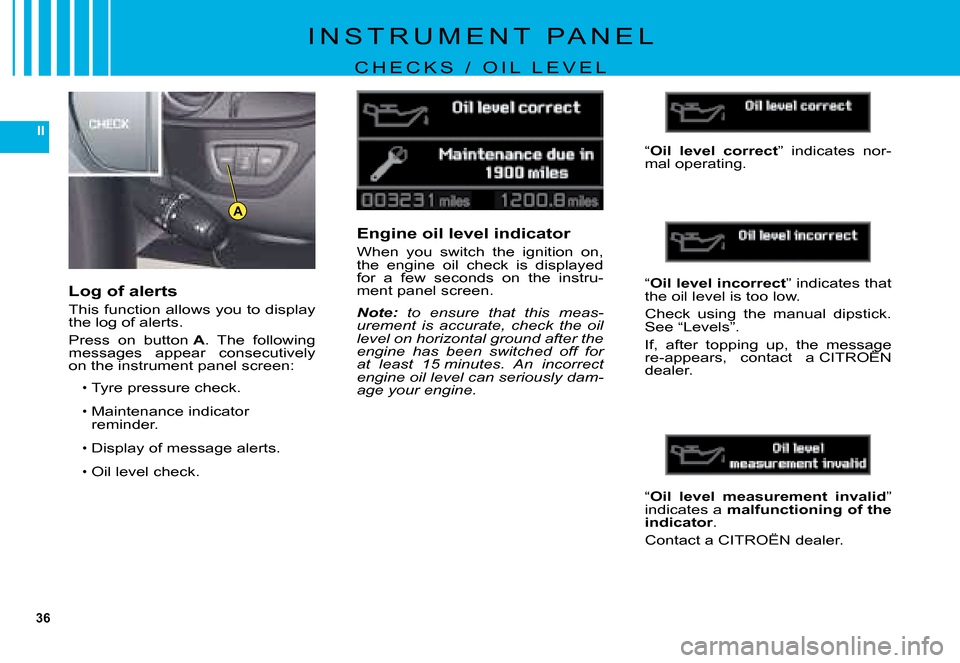
36
II
A
I N S T R U M E N T P A N E L
�C �H �E �C �K �S � �/ � �O �I �L � �L �E �V �E �L
Engine oil level indicator
�W�h�e�n� �y�o�u� �s�w�i�t�c�h� �t�h�e� �i�g�n�i�t�i�o�n� �o�n�,� �t�h�e� �e�n�g�i�n�e� �o�i�l� �c�h�e�c�k� �i�s� �d�i�s�p�l�a�y�e�d� �f�o�r� �a� �f�e�w� �s�e�c�o�n�d�s� �o�n� �t�h�e� �i�n�s�t�r�u�-�m�e�n�t� �p�a�n�e�l� �s�c�r�e�e�n�.
Note: to ensure that this meas-urement is accurate, check the oil level on horizontal ground after the engine has been switched off for at least 15 minutes. An incorrect engine oil level can seriously dam-age your engine.
“Oil level incorrect�”� �i�n�d�i�c�a�t�e�s� �t�h�a�t� �t�h�e� �o�i�l� �l�e�v�e�l� �i�s� �t�o�o� �l�o�w�.
�C�h�e�c�k� �u�s�i�n�g� �t�h�e� �m�a�n�u�a�l� �d�i�p�s�t�i�c�k�.� �S�e�e� �“�L�e�v�e�l�s�”�.
�I�f�,� �a�f�t�e�r� �t�o�p�p�i�n�g� �u�p�,� �t�h�e� �m�e�s�s�a�g�e� �r�e�-�a�p�p�e�a�r�s�,� �c�o�n�t�a�c�t� �a� �C�I�T�R�O��N� �I�f�,� �a�f�t�e�r� �t�o�p�p�i�n�g� �u�p�,� �t�h�e� �m�e�s�s�a�g�e� �I�f�,� �a�f�t�e�r� �t�o�p�p�i�n�g� �u�p�,� �t�h�e� �m�e�s�s�a�g�e�
�d�e�a�l�e�r�.
“Oil level measurement invalid�”� �i�n�d�i�c�a�t�e�s� �a� malfunctioning of the indicator.
�C�o�n�t�a�c�t� �a� �C�I�T�R�O��N� �d�e�a�l�e�r�.
“Oil level correct�”� �i�n�d�i�c�a�t�e�s� �n�o�r�-�m�a�l� �o�p�e�r�a�t�i�n�g�.
Log of alerts
�T�h�i�s� �f�u�n�c�t�i�o�n� �a�l�l�o�w�s� �y�o�u� �t�o� �d�i�s�p�l�a�y� �t�h�e� �l�o�g� �o�f� �a�l�e�r�t�s�.
Press on button A�.� �T�h�e� �f�o�l�l�o�w�i�n�g� �m�e�s�s�a�g�e�s� �a�p�p�e�a�r� �c�o�n�s�e�c�u�t�i�v�e�l�y� �o�n� �t�h�e� �i�n�s�t�r�u�m�e�n�t� �p�a�n�e�l� �s�c�r�e�e�n�:
Tyre pressure check.
�M�a�i�n�t�e�n�a�n�c�e� �i�n�d�i�c�a�t�o�r� �r�e�m�i�n�d�e�r�.
�D�i�s�p�l�a�y� �o�f� �m�e�s�s�a�g�e� �a�l�e�r�t�s�.
Oil level check.